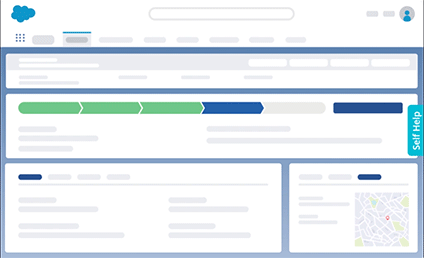Digital transformation has laid the groundwork for businesses to integrate new technologies for years. Now artificial intelligence (AI) is again redefining work, unlocking new levels of efficiency, innovation, and strategic decision-making.
AI has become the driving force behind the evolution of digital transformation, turning basic upgrades into groundbreaking innovations. By harnessing the power of AI, organizations are not only streamlining processes but unlocking entirely new ways of operating, innovating, and competing.
AI is the master craftsman in the digital workshop of transformation. While digital transformation provided the foundational tools—like cloud computing, IoT, and automation, among others—AI has stepped in to refine and elevate every process, much like an artisan turning raw materials into intricate, valuable creations. It doesn’t just optimize workflows; it anticipates needs, reshapes strategies and unlocks capabilities businesses didn’t know they had.
With AI at the helm, digital transformation evolves from a blueprint to a living, adaptive masterpiece, enabling businesses to innovate, scale, and thrive in a competitive landscape.
From automating repetitive tasks to delivering personalized customer experiences, AI is reshaping how businesses operate at every level. Its transformative potential extends across all business units and functions—from marketing and customer service to supply chain and HR—creating value faster than ever.
In this article, we’ll explore what AI transformation is, technologies driving AI transformation, and how to create a winning AI transformation strategy.
What Is AI Transformation?
AI transformation is a strategic initiative in which businesses integrate artificial intelligence into their operations, products, and services, fundamentally reshaping how they deliver values and achieve their goals. Furthermore, AI transformation reimagines workflows and strategies, creating agile organizations that thrive in today’s dynamic environment.
Unlike traditional digital transformation, which focuses on adopting a broader range of digital technologies and laying the groundwork for technology upgrades, AI transformation leverages the unique capabilities of AI to drive innovation, efficiency, and growth. At its core, AI transformation employs advanced technologies such as machine learning (ML), deep learning models, natural language processing (NLP), computer vision, and generative AI (GenAI) to develop systems that can:
- Automate repetitive tasks and administrative processes, saving time and resources.
- Improve decision-making through advanced data analytics and predictive insights.
- Deliver hyper-personalized customer experiences through AI-powered recommendations and interactions.
- Improve productivity and collaboration by augmenting human capabilities with AI-driven tools.
- Modernize IT systems with AI-enabled code generation and automated testing.
A recent IBM Institute for Business Value report (titled Augmented Work for an Automated AI-Driven World) highlights the impact of AI transformation, showing that businesses leveraging AI in their strategies consistently outperform competitors in efficiency, innovation, and adaptability.
The Transformative Value of AI
AI transformation delivers value across all business functions, reshaping how organizations operate. For example:
- HR: AI simplifies talent acquisition, enhances employee training through personalized paths, and supports workforce analytics to drive better decisions.
- Marketing and Sales: AI enables hyper-personalized customer experiences, streamlines sales processes, and automates A/B testing for conversion optimization.
- IT and Operations: AI automates routine tasks, improves system reliability, and modernizes applications, boosting agility and scalability.
- Finance and Supply Chain: AI-powered analytics optimize resource planning, forecast demand, and detect potential risks to mitigate disruptions.
- Customer Support: AI-powered support agents can triage inbound requests, deflect common help desk issues, and provide self-help resources by integrating with a company’s support repositories.
These examples demonstrate AI’s role as a catalyst for innovation, turning traditional operations into adaptive, data-driven ecosystems that drive growth and resilience.
By redefining workflows and unlocking entirely new ways of working, AI transformation empowers businesses to embrace opportunities beyond traditional digital transformation’s scope. It’s not just about adopting AI—it’s about using AI to create meaningful organizational change.
Technologies Driving AI Transformation
AI transformation relies on diverse cutting-edge technologies, each contributing unique capabilities to reimagine how businesses operate and innovate. These technologies form the backbone of AI-driven solutions, enabling organizations to automate processes, derive insights, and create value in new and impactful ways.
Key technologies driving AI transformation include:
- Natural Language Processing (NLP): Enables machines to understand and respond to human language, powering chatbots, virtual assistants, and sentiment analysis.
- Generative AI (GenAI): Creates original content, from text to images, for applications in personalized marketing, content creation, and rapid prototyping.
- Optical Character Recognition (OCR): Converts printed or handwritten text into machine-readable formats for document digitization and automation.
- Computer Vision: Interprets and analyzes visual data for applications like facial recognition, object detection, and real-time monitoring.
- Intelligent Automation: Combines AI with robotic process automation (RPA) to handle complex, repetitive tasks with minimal human intervention.
- Decision Support Systems: Aggregates and analyzes large datasets to provide actionable insights for strategic planning.
- Big Data Analytics: Extracts meaningful insights from massive datasets, enabling data-driven decision-making and forecasting.
AI Adoption in Enterprises
Artificial intelligence has evolved from a technological tool to a strategic driver of transformation. It’s not just reshaping digital transformation—it’s redefining how organizations innovate, operate, and create value. For enterprises, AI adoption represents more than implementing new technologies; it requires a transformative mindset that unlocks untapped potential across all business functions.
AI adoption accelerates across industries, enabling businesses to optimize workflows, uncover actionable insights, and deliver hyper-personalized experiences. According to IDC’s 2025 FutureScape report, worldwide spending on AI-supporting technologies is expected to reach $337 billion by 2025. Notably, 67% of this investment will focus on embedding AI capabilities directly into core operations rather than relying solely on third-party service providers. This trend underscores AI’s critical role in driving efficiency, innovation, and competitive differentiation.
Overcoming AI Adoption Challenges
Despite its vast potential, the journey toward AI adoption is not without challenges. Businesses face several hurdles for specialized training and talent acquisition.
- Skills Gaps: A shortage of expertise in AI development and deployment has created an urgent need for specialized training and talent acquisition.
- Workforce Resistance: Employees may resist AI adoption due to fears of job displacement or difficulties adapting to new tools and processes. For example, introducing AI-driven systems without proper training can result in apprehension and pushback.
- Legacy System Integration: Outdated IT infrastructure often lacks the APIs and compatibility required for seamless AI integration, requiring extensive upgrades, disrupting workflows, and driving up costs.
- Data Governance: Ensuring clean, secure, and consistent data for AI models remains a persistent challenge, as does compliance with evolving regulatory requirements.
- Ethical Concerns: Addressing algorithmic bias, ensuring transparency, and maintaining accountability are critical to building trust and fairness in AI-driven decisions.
Unlocking Opportunities with AI
Enterprises that strategically address these challenges are better positioned to unlock AI’s transformative potential. By modernizing infrastructure, upskilling employees, and adopting ethical AI practices, organizations can unlock opportunities for growth and innovation:
- Enhanced Operation Efficiency: Automating repetitive tasks and optimizing workflows allows teams to focus on high-value, strategic initiatives.
- Data-Driven Decision Making: Advanced analytics and machine learning empower organizations to uncover actionable insights and make smarter decisions faster.
- Personalized Customer Experiences: Through AI-driven recommendations and predictive behaviors, hyper-personalization fosters loyalty and increases revenue.
- Innovation Across Business Functions: From product development to supply chain optimization, AI fosters creativity and adaptability in previously unimaginable ways.
- New Revenue Streams: Businesses leverage AI to launch services like predictive maintenance, personalized consulting, and AI-driven product recommendations.
By embracing AI adoption, businesses can transform obstacles into opportunities, driving innovation, efficiency, and sustained growth. Those who harness AI effectively are not merely adapting to a changing landscape—they are defining the future of their industries.
How AI Is Shaping Digital Transformation Across Industries
Several industries are at the forefront of AI adoption, leveraging its transformative potential to redefine their core business practices and provide innovative solutions that enhance their customer experience and add additional value. Let’s explore a few sectors that are early adopters to see how they’re leveraging AI technologies and transforming their industries:
- Healthcare: AI is transforming healthcare by enhancing diagnostics, improving patient care, and accelerating drug discovery. It enables precision medicine by identifying patterns in complex datasets and supports quicker decision-making for better outcomes. AI-powered chatbots offer patients 24/7 assistance, enabling them to book online appointments, receive prescriptions for common illnesses, and access critical health information effortlessly.
- Retail: In the retail industry, AI is driving retail transformation by optimizing inventory management, predicting demand, and delivering hyper-personalized shopping experiences through data-driven analytics and recommendations. AI chatbots enhance customer support by assisting with account issues, returns, and personalized shopping advice, creating a seamless customer journey.
- Manufacturing: AI in manufacturing is boosting production efficiency through predictive maintenance, reducing downtime, and enhancing quality control with real-time analytics. This AI-powered manufacturing transformation also optimizes supply chains by forecasting demand and improving logistics, leading to cost savings and streamlined operations.
- Finance: AI-powered tools in the financial sector are transforming fraud detection, automating compliance processes, and providing personalized financial advice at scale. Robo-advisors and chatbots enable customers to manage investments, track spending, and receive tailored insights for improved financial health.
- Education: The education sector is experiencing rapid AI transformation through personalized learning platforms, intelligent tutoring systems, and administrative automation. AI tools analyze student performance data to provide tailored learning experiences and help educators identify areas where students may need additional support. Administrative AI tools streamline admissions, grading, and curriculum planning.
- Logistics and Supply Chain: AI is reshaping logistics by improving route optimization, enhancing demand forecasting, and enabling real-time tracking of goods. Autonomous vehicles and drones powered by AI are reducing delivery times and operational costs, while predictive analytics enhances supply chain resilience and efficiency.
Benefits of AI Transformation
AI transformation reshapes organizations by unlocking unparalleled efficiency, innovation, and customer value. AI fosters transformative growth across industries by automating workflows, enhancing decision-making, and personalizing experiences.
Below is a detailed look at the core benefits of AI transformation:
- Automation of Administrative and Manual Tasks: AI eliminates repetitive tasks, such as data entry and scheduling, by automating processes with precision and speed. This enables employees to focus on high-value, strategic activities.
- Big Data Analytics for Insights and Decision-Making: Advanced analytics powered by AI process vast datasets to generate actionable insights. Businesses can optimize processes, forecast trends, and make informed decisions faster and more accurately.
- Improved Knowledge Access and Sharing: AI-powered tools like intelligent search and content categorization simplify access to critical information. Employees can quickly retrieve relevant data, fostering collaboration and innovation.
- Enhanced Customer Experiences with Personalization: AI enables hyper-personalized interactions by analyzing customer behavior and preferences. From tailored recommendations to intelligent self-service tools, businesses can deliver exceptional customer service that boosts loyalty.
- Automated A/B Testing and Conversion Optimization: AI streamlines marketing campaigns by running automated A/B tests and optimizing content to improve conversion rates. This reduces time to market and increases campaign efficiency.
- Legacy App Modernization with AI-Powered Code Generation: AI transforms outdated IT systems by generating and optimizing code, enabling seamless integration with modern applications. This ensures scalability and supports long-term growth.
AI Transformation Use Cases by Job Function
Artificial Intelligence (AI) is revolutionizing how businesses function across every department. From enhancing customer experiences to streamlining IT and security, AI’s capabilities enable organizations to innovate, optimize, and outperform competitors.
Organizations like NovaMart, a hypothetical global retail chain, have successfully implemented AI to enhance customer service, optimize inventory, and drive personalized marketing strategies. Let’s explore how AI transforms specific job functions in similar ways, creating new efficiencies and delivering measurable impact.
1. Customer Service
AI-powered customer service delivers faster, more personalized experiences and automates routine tasks, including:
- Smart Case Classification Tools: AI systems like Salesforce Einstein route customer inquiries to the right support teams, streamlining resolution processes and improving customer satisfaction.
- AI Recommendation Engines: Platforms like Amazon’s algorithm analyze customer data to provide personalized product suggestions, increasing sales and user engagement.
- Conversational AI and Chatbots: From basic FAQ bots answering frequent questions to advanced conversational AI like ChatGPT, these tools automate responses from routine inquiries, reducing operational costs and improving response times. Virtual personal assistants like Siri and Alexa handle complex inquiries, while sophisticated platforms like Microsoft Power Virtual Agents intelligently route requests, ensuring seamless customer experiences. NovaMart, for example, reduced response times by 40% with AI-powered chatbots, significantly boosting satisfaction rates.
- Sentiment Analysis: AI analyzes customer sentiment to tailor customer responses, increasing engagement and satisfaction.
- Call Center Management and Operations: AI integrates computer vision to verify agent identity, streamline document handling, and ensure secure, efficient interactions within the call center itself.
2. IT and Security
AI strengthens IT infrastructure and cybersecurity measures, safeguarding businesses against modern threats while automating routine operations for improved efficiency. Key applications include:
- Automated Threat Detection: AI continuously monitors systems to identify and mitigate real-time risks.
- Anomaly Detection: AI tools help prevent potential breaches and operational disruptions by detecting unusual patterns.
- Predictive Security: Analyzing historical data enables AI to identify vulnerabilities and implement preemptive measures, reducing downtime and enhancing reliability.
- Enhanced IT operations: AI automates routine tasks like system updates and patch management, freeing IT teams to focus on innovation.
- Advanced AI Security Tools: Solutions like Darktrace’s Enterprise Immune System monitor cybersecurity threats with AI-driven insights, identifying and responding to emerging risks. For specialized physical security applications, systems like AVATAR, developed by the US Department of Homeland Security, analyze body gestures and facial expressions to enhance screening processes in governmental contexts.
3. DevOps
AI is reshaping DevOps practices, introducing automation and intelligence into software development and operational workflows. By incorporating AI into DevOps, organizations can accelerate development cycles, improve software reliability, and focus on innovation rather than repetitive tasks:
- Automated Code Testing: AI tools validate and test code automatically, significantly reducing errors and accelerating development timelines.
- Continuous Monitoring: AI-driven monitoring tools provide real-time insights into application performance, ensuring seamless operations and rapid issue resolution.
- Predictive Issue Resolution: AI anticipates potential failures or bottlenecks, proactively suggesting solutions before they impact user experience.
- Resource Optimization: AI dynamically allocates resources to meet demand, optimizing performance during peak usage without over-provisioning.
These advancements enable businesses to maintain high-quality deployments while scaling operations efficiently.
4. Sales
AI revolutionizes sales processes by automating routine tasks and providing actionable insights. It enables sales teams to work smarter and close deals faster. Key innovations include:
- Smart Assistants: Tools like Google’s Nespresso Assistant predict customer needs through a three-step process—asking targeted questions, recommending relevant products, and finalizing sales with minimal human intervention.
- AI-Based Guided Selling: According to Gartner, 60%of B2B sales organizations will transition from traditional, manual, and intuition-based approaches to data-driven selling by 2025, leveraging predictive analytics and prescriptive “next best action” recommendations to navigate complex sales processes more efficiently.
- Personalized Sales Recommendations: AI analyzes customer behavior and historical data to generate tailored offers, increasing conversion rates and fostering long-term customer relationships. NovaMart, for example, boosted email campaign engagement by 30% using AI-driven personalization, fostering deeper customer loyalty.
- Automated Lead Prioritization: AI-powered systems rank leads based on conversion potential, helping sales teams focus on high-value opportunities.
These AI-driven tools empower sales teams to optimize their efforts, improve productivity, reduce decision-making cycles, and increase overall customer satisfaction.
5. Business Operations
AI optimizes business operations by automating workflows, enhancing data analysis, and predicting performance outcomes to drive operational efficiency. Applications include:
- Data Management: AI tools like Google Big Table effectively store and analyze vast amounts of data, enabling better decision-making.
- Predictive Analytics: Tools like SAS Advanced Analytics integrate anomaly detection and sentiment analysis to pinpoint opportunities and mitigate risks. For instance, NovatMart leveraged predictive analytics to cut overstock by 25%, ensuring efficient inventory management.
- Operational Automation: AI-powered robots handle repetitive tasks, improving efficiency and reducing costs.
- Anomaly Detection: AI prevents outages by identifying disruptions in business processes early.
- Supply Chain Optimization: AI transforms supply chain management with predictive demand forecasting, logistics optimization, and supplier evaluation. For example, AI tools assess supplier reliability, cost, and sustainability to optimize procurement decisions while reducing waste.
6. Cloud Security and Optimization
AI revolutionizes cloud computing by enhancing security and optimizing resource management, enabling organizations to maintain scalable, efficient, and secure infrastructures:
- Automated Threat Detection: AI systems continuously monitor cloud environments, swiftly detecting and responding to potential threats.
- Dynamic Resource Allocation: By predicting usage patterns, AI adjusts resources in real time to meet demand without over-provisioning.
- Cost Optimization: AI identifies inefficiencies in resource usage, helping organizations reduce expenses while maintaining performance.
These innovations empower businesses to maximize the value of their cloud investments while mitigating risks.
7. Human Resources
AI enhances every stage of the employee lifecycle, from recruitment to retention, optimizing productivity, engagement, and well-being. Key applications include:
- Recruitment Optimization: AI matches candidates to roles through predictive analytics, improving hiring efficiency and reducing time-to-hire.
- Onboarding Automation: Personalized learning paths and employee self-service portals streamline onboarding processes, helping new hires integrate more effectively.
- Employee Engagement: AI-powered surveys and analytics gauge employee satisfaction, enabling HR teams to take proactive measures to improve morale and retention.
- Training and Development: AI creates tailored L&D strategies, ensuring employees remain upskilled, adaptable, and engaged.
- Employee Productivity and Well-Being: AI-powered wellness platforms monitor employee health and stress levels, recommending personalized wellness programs to promote work-life balance. For instance, NovaMart’s HR team implemented AI tools to streamline scheduling and focus employees on strategic goals, increasing workforce satisfaction.
AI’s role in HR ensures organizations attract, retain, and empower top talent while driving organizational success.
How to Create an AI Transformation Strategy
An effective AI transformation strategy is vital for organizations to harness AI’s full potential. This strategy must align with business objectives, embrace innovative tools, and foster a culture that supports continuous learning and adaptation. Addressing challenges such as data security, ethical concerns, skills gaps, and legacy systems during the strategy design phase will create a successful transformation strategy.
Here are the essential steps to guide organizations in crafting a successful AI transformation strategy:
1. Align Business Outcomes with Your AI Strategy
Begin by defining clear business goals that your AI initiatives will support. Identify key performance indicators (KPIs) to measure success and ensure that AI solutions align with your broader organizational objectives—such as improving customer experience, optimizing operations, or driving revenue growth.
Start by clearly understanding how AI systems will integrate into your IT ecosystem. Plan for potential modernization efforts, especially legacy systems, and adopt API-first strategies to ensure compatibility. Align these projects with business goals to maximize ROI and minimize disruptions.
2. Identify AI Technology and Tools that Drive Value
Evaluate the AI tools and technologies best suited to address your business challenges. Consider solutions like machine learning for predictive analytics, NLP for customer engagement, or computer vision for quality control. Choose technologies that can deliver measurable impact and scale with your organization.
Prioritize tools designed with data privacy in mind, such as those employing privacy-preserving techniques like federated learning or anonymization. Ensure your technology partners offer secure environments for AI deployment, aligning with regulatory requirements to protect sensitive information.
3. Document AI Wins and Learnings
Create a system for capturing and sharing successful AI use cases and lessons learned across teams. Highlight quick wins to build momentum and use these examples to refine your AI roadmap, ensuring continuous improvement and alignment with business priorities.
4. Upskill End-Users
Invest in upskilling programs to equip employees with the skills to use AI tools effectively. Foster a learning culture by providing training on AI technologies and their applications, ensuring your workforce is prepared to adapt to evolving demands.
Address workforce knowledge gaps with tailored upskilling programs that position AI as an enabler of meaningful work rather than replacing human roles. With a digital adoption platform (DAP) like Whatfix DAP, organizations can create in-app training experiences that guide employees through AI upskilling lessons, helping them realize the benefits of new technologies like AI faster. With onscreen guidance, employees can learn by doing, helping them adopt new workflows faster.
5. Design AI Operating Models
Develop an AI operating model that integrates AI workflows into your business processes. This includes defining roles, responsibilities, and governance structures to ensure seamless collaboration between AI teams and other business units. A well-designed operating model will facilitate scalability and ensure long-term success.
Establish ethical AI frameworks and regularly audit models to mitigate bias. By involving diverse teams in the development process, businesses can identify and address potential biases, ensuring fair and equitable decisions.
By following these steps, businesses can create a sustainable approach to AI adoption that drives immediate results and lays the foundations for sustained innovation and growth.

Driving AI Transformation Success with Whatfix
In the digital transformation workshop, artificial intelligence acts as the master craftsman, refining raw capabilities into extraordinary solutions. However, even the most skilled craftsman needs precision tools to bring their vision to life. This is where Whatfix excels—empowering businesses to harness the full potential of AI technologies through intuitive, user-centric guidance and support.
Tools like Whatfix’s Digital Adoption Platform (DAP) accelerate the integration of AI technologies by addressing adoption barriers. They ensure users not only understand the new tools and applications but also thrive when using them.
Key features of Whatfix’s DAP include:
- Interactive Walkthroughs: Step-by-step guides embedded within applications, helping users navigate processes effortlessly.
- Flows and Pop-ups: Highlight new features and workflows, accelerating onboarding and software adoption.
- Task Lists: Offer actionable steps to achieve their goals efficiently.
- Tooltips and Alert Beacons: Deliver contextual assistance to reduce confusion and improve user engagement.
- Embedded Knowledge Bases: Ensure on-demand access to resources, ensuring users stay informed and productive.
Whatfix doesn’t just support AI adoption; it enables businesses to realize the transformative potential of AI-driven tools and applications. By bridging the gap between complex systems and seamless user experiences, Whatefix ensures organizations can focus on innovation rather than troubleshooting.
Why Whatfix is the Essential Tool for AI Transformation
Much like AI shapes raw data into actionable insights, Whatfix shapes user interactions into seamless, productive experiences. Its capabilities include:
- Personalized Learning Experiences: Tailor training to user needs, helping employees adapt quickly to AI systems.
- Real-Time Support: Provide immediate, in-app assistance for an uninterrupted flow of work.
- Actionable Analytics: Gain insights into adoption metrics to refine strategies and drive continuous improvement.
- Cross-Industry Scalability: From healthcare to retail, Whatfix enables organizations across sectors to integrate AI successfully.
As businesses refine their digital blueprints into adaptive masterpieces, Whatfix serves as the essential companion—helping users unlock the full potential of AI tools, much like a master craftsman relies on precision instruments to create something extraordinary.














